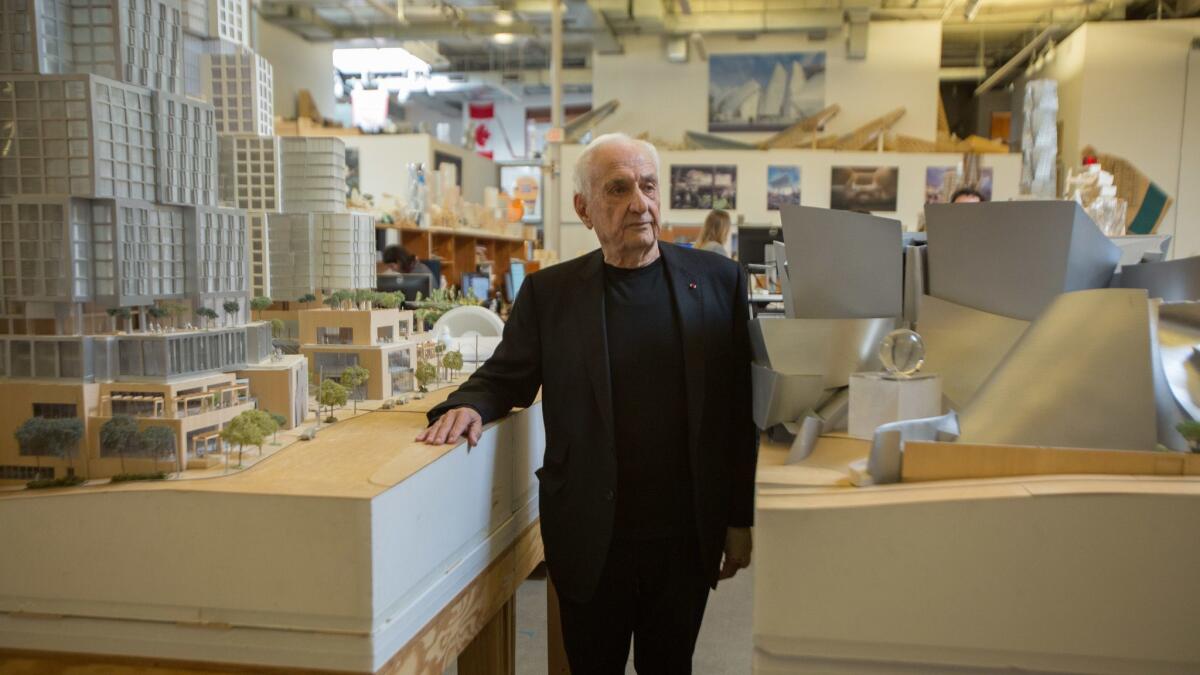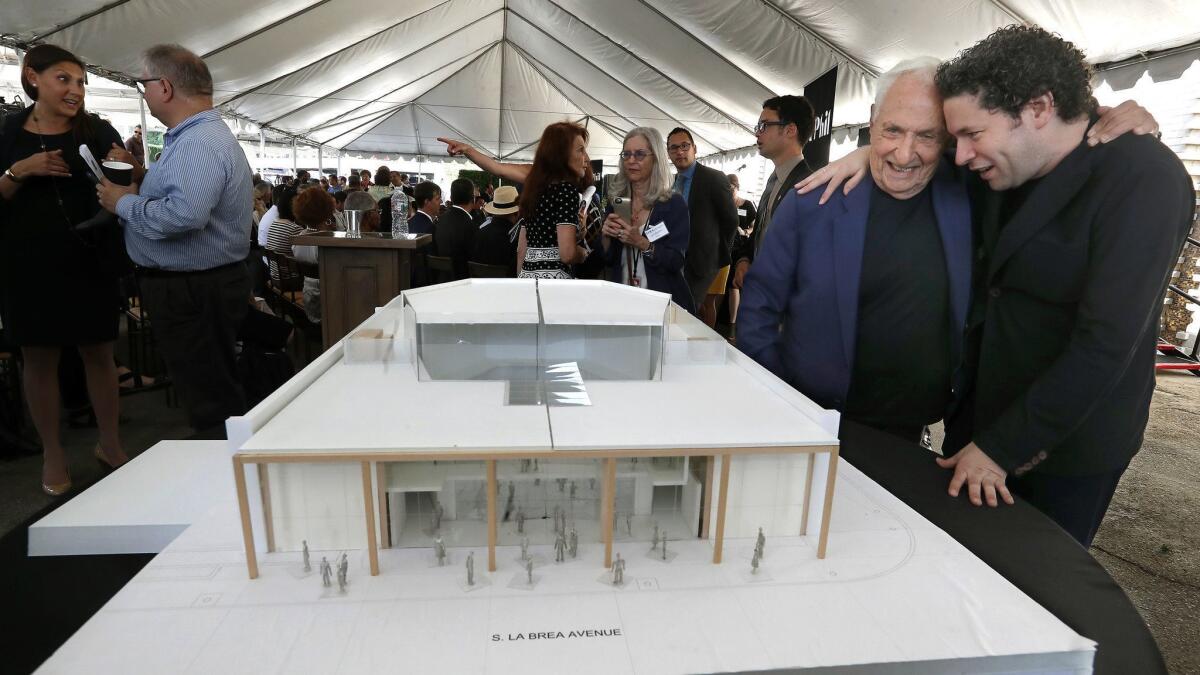Frank Gehry at 90: Aging, music and the one building he most wants to design

Frank Gehry, the celebrated Los Angeles architect of Walt Disney Concert Hall, is celebrating his 90th birthday out of town — way out of town. He heads to Berlin for a musical celebration in his honor Feb. 28 at the Gehry-designed Pierre Boulez Saal concert hall.
With all his global projects, not to mention local birthday festivities, how does he have the time?
In downtown L.A. alone, there’s his long-awaited $1-billion Grand residential, retail and hotel complex that broke ground this month, as well as an expansion for the nearby Colburn School, including a 1,100-seat concert hall, other performance venues and classrooms.
Grand and Colburn models of various sizes inhabit a big chunk of the floor space inside the sprawling Gehry Partners office, but that’s just the start. Besides projects planned for West Hollywood and Santa Monica, Gehry points out models of mixed-use skyscrapers for Toronto, residential towers for New York’s Hudson Yards and a new museum complex near his Fondation Louis Vuitton in Paris.
The architect, who moves pretty fast for a man nearing 90, next heads off to gaze with great pleasure at a series of photos of his newly built tower for art collector Maja Hoffmann’s cultural complex Luma Arles in Arles, France. “This fulfills my lifelong dream of painting with light,” he says. “Its stainless steel façade changes color in the sunlight. It is the light of Van Gogh.”
Tour over, he does a full stop in his office suite and settles into a cozy conference room whose walls are lined with books.
Painting and painters have always appealed to you, haven’t they?
From the beginning of my career, the architects who were in my peer group didn’t like what I was doing. Then, by luck, I connected with Ed Moses and other artists here. I found my comfort zone and the love, appreciation and sometimes even the respect I needed to keep going. They included me, and they treated me like one of them. I loved the idea of how direct their work was. It wasn’t all about theory. It was direct from the hand to the canvas or the sculpture. That was inspiring to me.
How did that directness differ from architecture?
Architecture includes more involvement of other people in your work: the client, the building department, engineers. There are the budget, the context and a lot more baggage. But in the end, it’s what you do with the form and space as you respond to problems, and that’s more like art. The art of architecture is what humanizes it, brings it to people and relates it to our lives. It’s not just bricks and mortar; it is potentially uplifting, inviting and intellectually stimulating.

You often use similar words in talking about the power of music and musicians.
In designing a building, you’re trying to create a feeling, and when I talk to musicians and composers, they also talk about trying to create a feeling. When I hang out with Esa-Pekka Salonen and talk about music, the struggle feels the same. I feel the search, and his reticence to talk about it and his joy when it is played are similar to my own feelings. Over the years, people like Esa Pekka, Zubin Mehta, Gustavo Dudamel and Michael Tilson Thomas have enriched my life a lot, and I think what I love most at this age is the friends I have made.
You once described a building to me in terms of its similarity to the Brandenburg concertos.
I think of musical composition and architecture as very similar in their layering of ideas toward the whole. Architecture is about making feelings with inert materials, and music is making masterpieces of wonder and creating spatial sound environments. Composers and musicians engage your being, and the spaces they play in become a significant part of that.
You do seem to be designing more and more concert halls. I just read that you’ve been working on a design for a concert hall in Wimbledon.
In my later years, I have been thinking a lot about classical music. I go to a lot of concerts, and my wife, Berta, loves classical music too, so it’s something we can do together. It’s a mutual pleasure. The culture of classical music and the artists involved are also very exciting to me. Instead of being in the culture of your own profession, it’s nice to remove yourself to another venue where you are enjoying the fruits of it but you are not in it. I like things you can admire and enjoy without getting into the politics of whatever is going on in that world behind the scenes.
So many architects, including you, don’t really become well-known until they’re older.
Like all people, architects also get older, and as we do, we tend to be more sought over for doing good work. You don’t usually get recognized until you’re in your 50s, and you need to have done a considerable amount of stuff before people pay attention to you in a serious way.
Do you think much about aging?
I didn’t retire, so the office is busy, and it feels like I’m struggling to stay up with it. I attribute it to aging, but whenever I say something like that to any of the senior people in the office, they always say they’re all feeling the same thing. The office is just busy, and we’re all struggling to keep up with it. Although aging grabs my attention, with physical changes and all, I forget about it once I start working.
Where does the learning lie in aging?
The most important thing you learn as you age is to not focus on all the aspects of your life that are worrisome and you can’t do anything about. If you watch the news, there’s so much negative in the world that you can fasten onto. I do it. We all do. But if you go back to work and start making things, it creates a positive corner of the world where you can feel comfort and solace.
What made you decide to spend your 90th birthday in Berlin?
When [pianist and conductor] Daniel Barenboim wrote me and asked if he could have my 90th birthday there, I said, “Sure. I’d love it.” I really believe people talk to each other through the arts, and even though I don’t follow religion anymore, I grew up as a Jew and certainly have the cultural DNA. Daniel’s West-Eastern Divan Orchestra is made up of young people from all over the Middle East, and when I read about it several years ago, I got excited about it. I went to auditions and saw these kids from very different backgrounds playing beautiful music together. I was subsequently asked to design their concert hall, and I decided to do it as a gift for them. It is very special to me.
Is there something you haven’t done yet architecturally that you would like to do?
Yes. I would like to design a church or a synagogue. A place that has transcendence. I’ve always been interested in space that transcends to something — to joy, pleasure, understanding, discourse, whatever a space can do to be part of the dialogue. Forget the religion aspect. How do you make a space feel transcendent? How do you create a sense of ease with the universe, the rain, the stars and the people around you? It’s comforting to sit in a big room and listen to the rain.
Barbara Isenberg is the author of “Conversations With Frank Gehry.”
Support our coverage of local artists and the local arts scene by becoming a digital subscriber.
See all of our latest arts news and reviews at latimes.com/arts.
More to Read
The biggest entertainment stories
Get our big stories about Hollywood, film, television, music, arts, culture and more right in your inbox as soon as they publish.
You may occasionally receive promotional content from the Los Angeles Times.






